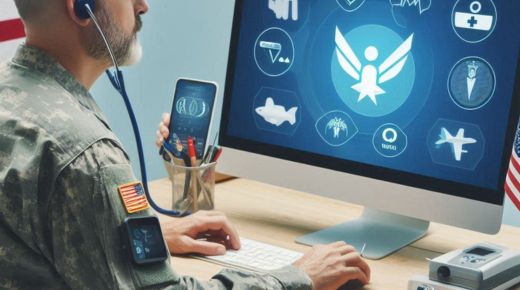
Chronic Obstructive Pulmonary Disease (COPD) represents a significant health challenge, particularly affecting veterans due to various exposures during military service. As one of the most common respiratory conditions, COPD requires meticulous management to ensure patient well-being and prevent exacerbations. The Veterans Affairs (VA) healthcare system, recognizing the unique needs of veterans, has embraced VA remote patient monitoring as an integral component to support those battling COPD.
Understanding COPD in Veterans
COPD is characterized by persistent respiratory symptoms and airflow limitation, primarily caused by significant exposure to noxious particles or gases. Veterans, especially those exposed to diesel fumes, burn pits, and other environmental hazards during service, are at heightened risk for developing this condition. The progression of COPD can severely impair daily life and mobility, necessitating a comprehensive and continuous healthcare approach.
The Role of Remote Patient Monitoring
Remote patient monitoring (RPM) offers a revolutionary way to manage chronic diseases like COPD. By leveraging technology, healthcare providers can monitor patient data in real-time, enabling timely interventions without frequent in-person visits. This form of care is particularly beneficial for veterans who may face mobility issues, reside in rural areas, or have limited access to specialized healthcare facilities.
Key Features of VA Remote Patient Monitoring
Continuous Health Metrics Monitoring: For veterans with COPD, RPM involves regularly tracking key indicators such as oxygen saturation levels, heart rate, and respiratory rates. Portable devices facilitate these measurements, allowing veterans to self-monitor or enable remote data transmission to healthcare providers.
Symptom Tracking and Alerts: Patients have tools to log symptoms like breathlessness and cough intensity. The system can flag deviations from standard patterns, triggering alerts for healthcare teams to assess and potentially intervene, preventing severe exacerbations.
Education and Self-Management Tools: Empowering veterans with knowledge about COPD management is critical to RPM. Educational resources delivered through software applications help veterans understand disease management, medication adherence, and lifestyle modifications.
Telehealth Intervention: RPM often integrates with telehealth services, allowing veterans to consult with healthcare providers via video calls. These consultations are essential for routine assessments, medication adjustments, and emotional support to patients and their families.
Benefits of RPM for COPD Management
Improved Health Outcomes
RPM systems have demonstrated clear advantages in managing COPD, including reducing hospitalization rates and minimizing the frequency of acute exacerbations. Veterans experience better disease control and reduced emergency healthcare needs with continuous monitoring and proactive healthcare interventions.
Enhanced Access to Care
One of the significant hurdles veterans face is accessing timely healthcare. RPM bridges this gap by enabling consistent and convenient care, regardless of location. Veterans can receive quality healthcare services without extensive travel or disrupting their routine, which is especially valuable for those in remote or underserved communities.
Cost-Effective Healthcare
Frequent hospital visits and emergency care can be costly. RPM offers a cost-effective alternative by minimizing the need for in-person consultations and potential hospitalizations. Veterans receive quality care while helping the VA system effectively manage resources and reduce overall healthcare costs.
Personalized Patient Care
RPM allows healthcare providers to tailor interventions based on real-time data and trends. Each veteran receives customized care plans considering their unique health status and history. This personalized approach enhances treatment efficacy, and fosters improved patient satisfaction.
Challenges and Considerations
While RPM offers numerous benefits, several challenges need addressing to maximize its potential:
Technological Challenges
Implementing RPM requires reliable technology infrastructure, including internet access and device connectivity. Some veterans, especially older adults or those in rural areas, may face barriers to effectively accessing and utilizing these technologies. To ensure successful RPM implementation, the VA must provide comprehensive support, including technical assistance and device training.
Data Privacy and Security
With the increased digitalization of health data, robust cybersecurity measures to protect sensitive patient information are paramount. The VA must prioritize data privacy, comply with regulations, and implement stringent security protocols to safeguard veterans’ health data.
Patient Engagement and Compliance
For RPM to be practical, veterans must actively engage with the monitoring process, adhere to using prescribed devices, and communicate consistently with healthcare providers. Developing user-friendly technology and fostering a solid patient-provider relationship are crucial steps to ensure compliance and engagement.
The Future of RPM in Veteran Healthcare
The progression and refinement of RPM technologies hold immense promise for enhancing the quality of care for veterans with COPD and other chronic conditions. As the VA continues to innovate and integrate these systems, the potential for improved health outcomes and quality of life for veterans is vast. Future developments may include more sophisticated health analytics, broader telehealth integrations, and expanded patient education initiatives. Ultimately, RPM has the potential to transform the way healthcare is delivered to veterans, improving access, efficiency, and overall patient satisfaction. So, let’s embrace this technology and continue working towards providing comprehensive and continuous care for our deserving veterans.
Conclusion
Remote Patient Monitoring (RPM) is transforming the landscape of veteran healthcare, especially for chronic conditions like COPD. By incorporating advanced technology and a patient-centric approach, RPM ensures veterans receive timely and effective care without unnecessary barriers. Platforms like DocVA play a crucial role in this transformation, facilitating seamless communication between veterans and healthcare providers.
The initiatives undertaken by the VA to address technological challenges, data privacy, and patient engagement are pivotal in maximizing the benefits of RPM systems. As healthcare continues to evolve, the integration of RPM will likely expand and become a cornerstone of veteran care, offering personalized and efficient healthcare solutions. By focusing on continuous improvement and adaptation, the VA can ensure that veterans lead healthier, more independent lives, greatly enhancing their well-being and quality of life. Tools like DocVA will be essential in supporting this mission, empowering veterans to take an active role in their health management.




